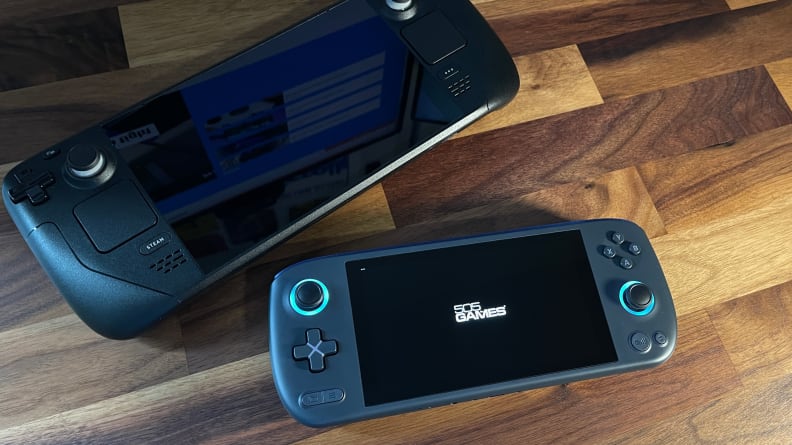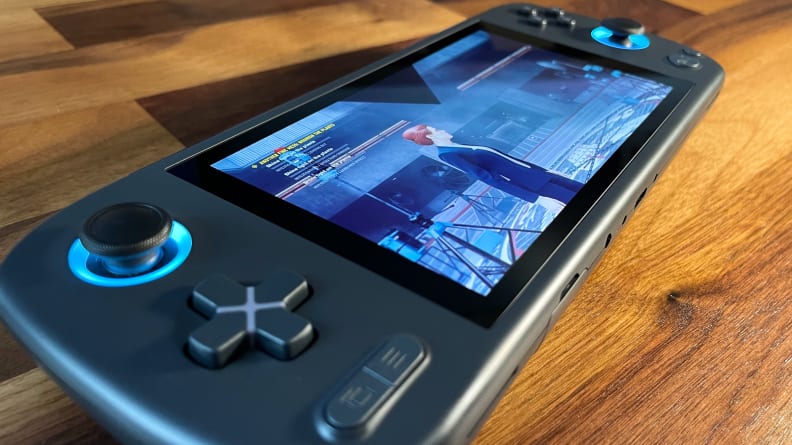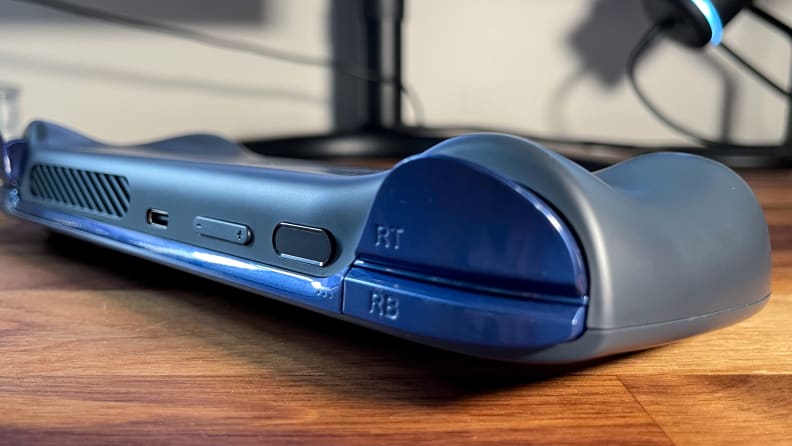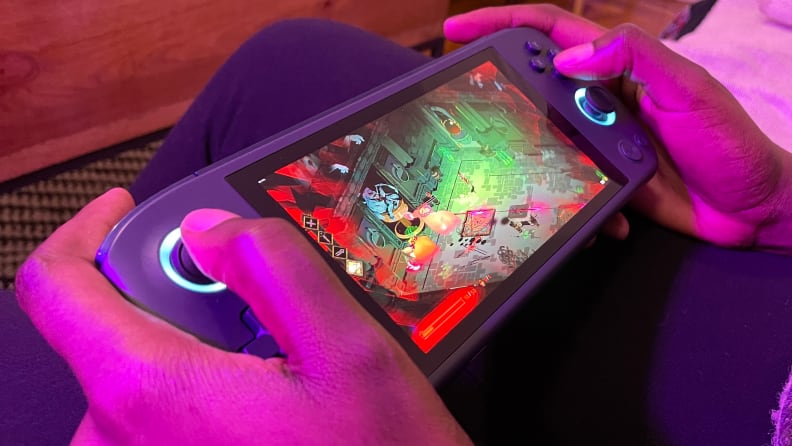Pros
-
OLED screen
-
Great size and weight
-
Premium features
The Ayaneo Air Pro might be the best handheld for emulation, period, but the price is likely too steep for most people.
About the Ayaneo Air Pro

Credit:
Reviewed / Jonathan Hilburg
The Ayaneo Air Pro is three inches shorter than the Steam Deck.
Here are the specs of the handheld we tested:
- Price: $1,099 (as configured)
- Processor: AMD Ryzen 7 5825U (8-core, 16-threads), 2.0GHz base clock, 4.5Ghz boost
- Graphics: AMD Radeon integrated graphics
- Memory: 16GB LPDDR4x at 4266Mhz
- Storage: 1TB PCIe 3.0 NVMe SSD
- Battery: 38Whr
- Display: 1920 x 1080, 5.5-inch AMOLED touchscreen, 350 nits (rated), 60Hz
- Dimensions: 8.81 x 3.52 x 0.85 inches (at thinnest point)
- Weight: 440 grams (15.52 ounces)
- Connectivity: Wi-Fi 6, Bluetooth 5.2, 2 x USB-C with DisplayPort 1.4 Alt-mode support, 1 x 3.5mm headphone jack, USB 3.0 class TF card reader
- Colors: Aurora White, Polar Black, Bright Silver
- Additional features: Hall effect joysticks and triggers, A-B X-Y key swap, fingerprint reader, one additional left and right shoulder button, LED-illuminated thumbsticks
There are three different models of the Ayaneo Air: the Ayaneo Air Lite, regular Air, and Air Pro. The Ayaneo Air and Air Lite are functionally identical to the Pro model, but come in at 0.7 inches (18mm) thick instead of 0.85 inches (21.6 mm). All three can be configured with a base AMD Ryzen 5 5560U CPU, but the Air Pro tops out at a Ryzen 7 5825U CPU, which has more two more cores and four more threads. The non-Pro models feature a smaller 28Whr battery, whereas the Pro version uses a 38Whr capacity battery.
All models come preinstalled with Windows 11, use the same AMOLED screen, and use full-sized 2280 M.2 NVME drives. The base Ayaneo Air Lite starts at $549 but only includes 8GB of RAM and 128GB of storage. The base Air Pro begins at $699 for 16GB of 4266Mhz DDR4 RAM and 512GB of storage, but can be configured with up to 32GB of RAM and 2TB of internal storage.
What we like

Credit:
Reviewed / Jonathan Hilburg
Thanks to its AMOLED screen, color, contrast, and viewing angles are excellent.
It’s thin and light
It’s impossible to hold the Ayaneo Air Pro and not think “quality.” The entire assembly, down to the metallic triggers and shoulder buttons, and ring of programmable LEDs under the thumbsticks, feels well put together. Ayaneo has created a handheld gaming PC that truly feels small enough to slide into a jacket pocket–it’s about the same size as the Nintendo Switch Lite.
Although the Ayaneo Air Pro is the same thickness as the Steam Deck, it feels more compact thanks to the three inches Ayaneo has shaved from that device’s length and the inch in height. The reduction in size doesn’t preclude extra features, including a second USB-C port on the Air Pro’s bottom, a fingerprint sensor in the power button, and four additional contextual face buttons like the Steam Deck. The fan is much quieter than the Steam Deck’s, even at full speed.
The Ayaneo Air Pro doesn’t include additional buttons on the back like the Deck, but I find those finicky to use. What will be a deal-breaker to some people is that the grips on the back of the Air and Air Pro are much less pronounced than the Steam Deck and use a slippier, untextured plastic.
In practice, this doesn’t matter too much (though our test unit did slide out of my hand once). After playing 35 hours of Enter the Gungeon on the Ayaneo Air Pro, I did have some complaints about the ergonomics overall, but comfort wasn’t one of them. I was consistently able to play for two- or three-hour blocks with only minimal hand strain.
The Windows experience
Ayaneo’s handhelds all run Windows, and the Air Pro is no different. Our unit came preinstalled with Windows 11 and AYASpace, a program that maps the Ayaneo Air’s buttons to Windows functions, allowing you to use the thumbsticks and face buttons to navigate. Having the keyboard premapped to a short press of the left top button, and CTRL+ALT+DEL to a long press of that same button, makes navigating on the 5.5-inch screen much easier.
Like the Steam Deck, a dedicated Ayaneo button opens a menu that lets you change the brightness, volume, total power draw (TDP) cap from five watts up to 12 watts, fan profiles, and other vital functions from one convenient place.
There aren’t many handhelds that can compete with the Steam Deck on performance thanks to Valve’s custom APU and DDR5 memory configuration, and none of the Ayaneo Air models are powerful enough to match it. But they can still run demanding games, and even emulate the Nintendo Switch.
At 12 watts, I was able to pull a constant 35 frames per second in Borderlands 3 at 720p with all settings on low. Elden Ring and Control were similar, both offering over 30 fps at similar settings. Baldur’s Gate 3 only ran at 20 fps at 12 watts, and I couldn’t get the game to recognize any of my controller inputs.
You can boost the power consumption all the way up to 18 watts through AYASpace and gain an additional 10 fps in heavier games, but I don’t recommend doing this unless the Ayaneo Air is charging, as it will severely reduce the battery life.
You shouldn’t have any trouble pushing indie games like Hades, Enter the Gungeon, Sable, and Hollow Knight to 60 fps at 1080p. The additional pixel density really helps them shine, and load times will be noticeably faster than the Nintendo Switch ports.
Because the Ayaneo Air runs Windows 11 and can output a DisplayPort 1.4 signal over USB-C, it can also pull double duty as a full-fledged desktop. I had no problem connecting to my monitor via USB-C, pairing a gaming mouse, and connecting a keyboard over Bluetooth while charging at the same time.
Unlike the Steam Deck, you’re not natively limited to Steam games, and I was able to make full use of the free games I’ve been claiming from the Epic Store. Emulators were similarly easy to set up and configure.
The gorgeous screen
The other main selling point of the Ayaneo Air is the 5.5-inch, 1080p OLED screen all models come equipped with. Contrast, color accuracy, uniformity, pixel response times, and viewing angles are all fantastic.
Every game I tested, even at low settings or 720p resolution, looked stunning. Because OLED screens can produce perfect black levels, shadows in Control are deep and lifelike, and the colors in Elden Ring pop more than enough to compensate for the lowered background quality.
The Ayaneo Air’s screen suffers none of the backlight bloom that’s common on the Steam Deck. When playing on the Deck, I also noticed a yellow pall in Enter the Gungeon that wasn’t prevalent on the Ayaneo handheld. The screen isn’t perfect, but my issues with it are minor. Ayaneo opted for a super glossy coating that both enhances the contrast but left me staring at my own face in darker games.
It’s also a fingerprint magnet, which is an issue when navigating via the touchscreen is the easiest way to do things. The bezels are noticeably large, but less distracting on the white models where it blends into the plastic shell more.
Finally, 5.5 inches might be make-or-break for some people. I found it too small to comfortably play Borderlands 3 (I couldn’t make out distant enemies), and you might have trouble in text-heavy games like Cyberpunk 2077 or Disco Elysium. Divinity: Original Sin 2, a game with a lot of text and small UI elements, was playable, but I wouldn’t complete it this way. That said, it still looks much better than the Nintendo Switch port.
What we don’t like

Credit:
Reviewed / Jonathan Hilburg
The grips are thinner than the Steam Deck’s, but the triggers are satisfying to press.
The battery life
The Ayaneo Air Pro has a tiny battery. If you’re playing a AAA game and pushing the Air to its max power draw, you should only expect about an hour and a half of battery life. Playing indie games at a 12-watt cap will see about two to three hours before you’ll need to recharge.
That capacity will drop after a year of use, too. While Valve and iFixit offer replacement Steam Deck batteries, Ayaneo currently doesn’t.
Even worse, the non-Pro model has a 28Whr battery. Despite being thinner and lighter, I’d recommend staying away from that tier for that reason alone.
The ergonomics
Despite having the same footprint as the Nintendo Switch Lite, the Ayaneo Air Pro is less comfortable thanks to the added thickness. I have smaller hands, and frequently had to stretch to hit both the right trigger and thumbstick at the same time, causing me to miss some shots while gaming. I also often found my hands flexed into a claw grip.
Because it’s shorter than the Steam Deck, Ayaneo opted for downward-firing speakers instead of placing them on the front of the device. And, like the Retroid Pocket 3+, I found my pinkies had nowhere to go but curl upwards to cover them.
Not that it matters much; the speakers on the Ayaneo Air Pro aren’t great. To add insult to injury, Ayaneo shipped some Air and Air Pro units (including ours) with one of the speakers wired backwards, resulting in the sound being out of phase and extremely muffled. It’s easily fixable using a program called Equalizer APO, but an annoying oversight nonetheless.
The eye-watering price
The Ayaneo Air starts at $549. The base Ayaneo Air Pro starts at $699 and comes with an AMD Ryzen 5 5560U CPU, which is about 20% slower than the model we tested, and 16GB of RAM and 512GB of internal storage. That’s only $50 more than the 512GB Steam Deck, but Ayaneo has run sales in the past that brought the prices in line.
If you want to upgrade to a model with a Ryzen 5825U CPU you’ll pay $999, minimum. As configured, our unit, featuring a 1TB NVME storage drive, costs $1,099. If you want to go all the way up to the 2TB model with 32GB of RAM, expect to pay $1,399.
Unfortunately, while the Ayaneo Air Pro is packaged nicely, it also doesn’t come with a carrying case like the Deck does, a glaring omission for the price. There’s also the fact you can just buy the base Steam Deck for $399 and upgrade the internal 2230 NVME drive yourself and save $200.
Those kinds of numbers might be hard to swallow, but realistically, no one in the handheld gaming PC space can compete with Valve on price.
Should you buy the Ayaneo Air Pro?

Credit:
Reviewed / Jonathan Hilburg
The Ayaneo Air Pro is only a little larger than the Nintendo Switch Lite.
Maybe, if you don’t mind frequent trips to the charger
The Ayaneo Air Pro is everything I wish the Steam Deck was. It’s a truly portable handheld PC, can run big-name games well enough, and uses high-quality parts like an OLED screen and magnetic Hall Effect thumbsticks and triggers that won’t ever drift or stick. It may be the best device out there for running indie games and emulators, hands down.
At the same time, the base model of the Air Pro starts at the same price as the highest tier of Steam Deck. It doesn’t come with a carrying case, and although Ayaneo is active on Reddit and Discord, it can’t compete with the level of customer support or quality assurance that a massive company like Valve offers. All of that said, the Ayaneo Air and Air Pro are excellent devices that fill a niche Valve hasn’t reached yet—the mediocre battery life is the only thing holding them back from reservation-free recommendations.
If you like the form factor, the company will soon start taking preorders for the Ayaneo Air Plus, a $300 version of the Air with a 6-inch, 1080p IPS screen that’s powered by a weaker Intel Core i3 1215u processor. You won’t be able to hit 30 fps in newer games like Elden Ring, but it’s a cheaper alternative that should blast through older games and emulate WiiU, PlayStation 3, and some Switch games without issue.
The product experts at Reviewed have all your shopping needs covered. Follow Reviewed on Facebook, Twitter, Instagram, TikTok, or Flipboard for the latest deals, product reviews, and more.
Prices were accurate at the time this article was published but may change over time.
Meet the tester
Jonathan is an Electronics Editor for Reviewed specializing in gaming gear and has experience with everything from controllers to benchmarking the latest GPUs. He was previously the Web Editor at The Architect’s Newspaper.
Checking our work.
Our team is here for one purpose: to help you buy the best stuff and love what you own. Our writers, editors, and lab technicians obsess over the products we cover to make sure you’re confident and satisfied. Have a different opinion about something we recommend? Email us and we’ll compare notes.











